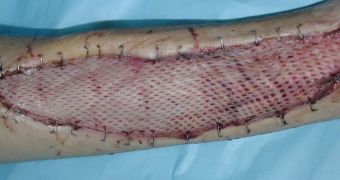Wrinkles can be history. At least in the case of burned victims that received skin grafts. A new gel could impede the painful and disfiguring contractions of skin grafts.
Irreparably burned skin can be replaced by grafts taken from other areas of the patient's body or made by tissue engineering. In most cases, the grafts heal successfully, but in about 30 % of the cases the skin wrinkles significantly and, besides the pain, this is disabling and very common amongst children.
A team from the University of Sheffield has presented at the Royal Society of Chemistry's Biomaterials conference in Manchester, UK, an enzyme-inhibiting drug which reduces by 50 % this contraction. The drug appears like a biocompatible polymer gel which can be smeared onto the graft.
"Currently the only accepted treatment for graft contraction is to have the patient wear pressure garments - extremely tight clothing that pushes down on the dermis to prevent it forming bumps of contracted tissue," lead researcher Sheila MacNeil told Chemistry World.
The team discovered that an enzyme named lysyl oxidase is a main factor in provoking the graft contraction, as it ties together collagen fibres in the derm (the profound layer of the skin). The researchers developed the drug based on a chemical named 3-aminopropionitrile which inhibits the lysyl oxidase. This molecule was combined with a biocompatible polymer gel developed by Sheffield chemist Steve Armes.
"The control grafts contract to about 60 % of their original size, but [when the drug is applied] they only contract down to 80 %. Our polymer gel is well tolerated by the skin and releases the drug in a controlled manner over about 48 hours," co-author Karima Bertal told Chemistry World.
"The team has now started testing the drug-gel combination itself on human skin samples, and early results looks promising. If they're successful, we would like to move into the clinic," said MacNeil.

 14 DAY TRIAL //
14 DAY TRIAL //